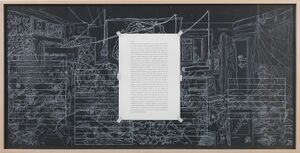Letters to the Red Crayola XI, 1982-2012
| Letters to the Red Crayola XI, 1982-2012 | |
|---|---|
 | |
| Art & Language | |
| Project | |
| Year | 2012 |
| Dimensions | 52.3 × 102.8 cm[1] |
| Materials | Ink, acrylic, collage and mixed media on paper |
Text
Dear M, It's not at all strange that people seem to 'get' '100% Abstract' rather more readily than other works of Conceptual Art. While the overt content of the work is textual, it is nevertheless a small painting and its 'covert' content involves a reference to a statement by Frank Stella, and thus to his pinstripe paintings. It is by no means a 'post medium' work, whatever that is. It's a little painting. You think it's quite likely that there were some within the curating institutions who, either explicitly or intuitively and vaguely, perceived in Conceptual Art a property necessary for the progressive erosion of the boundaries by which institutional expansion had been previously curtailed. It would be not at all surprising if those same or other individuals and institutions understood that these were conditions for considerable development — expansion — in the role of the curator. (Of course, someone might want to argue that expansion would have occurred without a postmodern settlement — that it's possible to imagine bigger and bigger collections of bigger and bigger abstract paintings and their sculptural counterparts, accompanied by a growing collection of drawings and archival stuff, including films, videos and so forth. And while this is undoubtedly possible, one feels that there would have remained a curtailing discourse, an aesthetic even. At the same time, it's inviting to speculate as to what might have been, had a more-or-less Art and Objecthood-friendly museum culture persisted into the era of hyper-profits and derivatives-based banking.) While we did not imagine any prolongation of the late modernist regime, (the '100% Abstract' work, for example, contemplates its destruction), we began to take the view in the 1970s that, among the potentially undesirable effects on artists of this expansionary development in the art and politics of the museum, were the inhibition of self-change and of the risks of inconsistency and self-destruction that is entrains, the discouragement of those types of internal complexity that don't do well under conditions of rapid distribution, circulation and consumption, and the identification of the artwork with the institution itself. As we admitted in the last week's letter, we stumbled and groped. Our own critical views had put us in a place of discomfort: the shit, and this became habitual.
Interpretations
- The text discusses 100% Abstract (1968)
- The background image references Index: The Studio at 3 Wesley Place in the Dark (1982)
- "Art and Objecthood" is a 1967 essay by Michael Fried